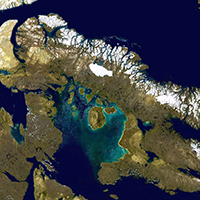Physical and chemical characteristics of 1300 lakes and ponds across the Canadian Arctic
Characteristics of Canadian Arctic lakes and ponds

Accepted: 25 August 2020
Supplementary: 107
HTML: 255
All claims expressed in this article are solely those of the authors and do not necessarily represent those of their affiliated organizations, or those of the publisher, the editors and the reviewers. Any product that may be evaluated in this article or claim that may be made by its manufacturer is not guaranteed or endorsed by the publisher.
Authors
Lakes and ponds are a major feature of the Arctic landscape and are recognized as effective ‘sentinels of change’. Here we present water chemistry characteristics of lakes and ponds (n=1300 with 26 variables) across the Canadian Arctic collated from published studies. We also extracted geological and ecoregion data in an attempt to determine the key drivers. In general, most lakes were shallow (85.4%, <10 m), nutrient (phosphorus) poor (oligotrophic = 45.6% and ultra-oligotrophic = 24.8%), located at low elevation (66.5%, <200 m asl), close to coastlines (72.5%, 0-50 km), and underlain by sedimentary geology (66.5%). The first two components from Principal Component Analysis explained 49.3% of the variation in the dataset; the first component was dominated by conductivity/carbonate materials, and the second component suggested allochthonous inputs of phosphorus. In general, bedrock geology is the primary driver of water chemistry; as such, there were major differences between lakes underlain by igneous and sedimentary rocks. Those on sedimentary bedrock tend to have higher pH, nutrients and higher inorganic ion concentrations.
Edited by
Michela Rogora, CNR-IRSA Verbania, ItalyHow to Cite
Similar Articles
- Monika Tarkowska-Kukuryk, Tomasz Mieczan, Effect of substrate on periphyton communities and relationships among food web components in shallow hypertrophic lake , Journal of Limnology: Vol. 71 No. 2 (2012)
- Yuanfeng Cai, Fanxiang Kong, Diversity and dynamics of picocyanobacteria and the bloom-forming cyanobacteria in a large shallow eutrophic lake (lake Chaohu, China) , Journal of Limnology: Vol. 72 No. 3 (2013)
- Angela Caro-Borrero, Javier Carmona Jiménez, Marisa Mazari Hiriart, Evaluation of ecological quality in peri-urban rivers in Mexico City: a proposal for identifying and validating reference sites using benthic macroinvertebrates as indicators , Journal of Limnology: Vol. 75 No. s1 (2016): Proceedings of the 6th National Congress of Limnology
- Barbara Leoni, Zooplankton predators and prey: body size and stable isotope to investigate the pelagic food web in a deep lake (Lake Iseo, Northern Italy) , Journal of Limnology: Vol. 76 No. 1 (2017)
- María Antonia Rodrigo, Adriana García, Allan R. Chivas, Carbon stable isotope composition of charophyte organic matter in a small and shallow Spanish water body as a baseline for future trophic studies , Journal of Limnology: Vol. 75 No. 2 (2016)
- Valeria Rossi, Catia Maurone, Giorgio Benassi, Silvia Marková, Petr Kotlík, Nicolò Bellin, Ireneo Ferrari, Phenology of Daphnia in a Northern Italy pond during the weather anomalous 2014 , Journal of Limnology: Vol. 74 No. 3 (2015)
- Baoli Wang, Cong-Qiang Liu, Fushun Wang, Benjamin Chetelat, Stephen C. Maberly, Diatoms modify the relationship between dissolved silicon and bicarbonate in the impounded rivers , Journal of Limnology: Vol. 72 No. 3 (2013)
- Owen Lind, Laura Dávalos-Lind, Carlos López, Martin López, Juli Dyble Bressie, Seasonal morphological variability in an in situ Cyanobacteria monoculture: example from a persistent Cylindrospermopsis bloom in Lake Catemaco, Veracruz, Mexico , Journal of Limnology: Vol. 75 No. s1 (2016): Proceedings of the 6th National Congress of Limnology
- Patrick E. Stücheli, Jutta Niggemann, Carsten J. Schubert, Comparison of different solid phase extraction sorbents for the qualitative assessment of dissolved organic nitrogen in freshwater samples using FT-ICR-MS , Journal of Limnology: Vol. 77 No. 3 (2018)
- Robert Sturm, Modelling ecological specificities of freshwater molluscs: the exemplary case of Bythinella austriaca (v. Frauenfeld, 1857) (Gastropoda, Prosobranchia) , Journal of Limnology: Vol. 75 No. 3 (2016)
<< < 23 24 25 26 27 28 29 30 31 32 > >>
You may also start an advanced similarity search for this article.
-
Jonathan B. Martin, Andrea J. Pain, Ellen E. Martin
-
Zhizhong Li, Madjid Hadioui, Kevin J. WilkinsonNanomaterials : 2023

 https://doi.org/10.4081/jlimnol.2020.1973
https://doi.org/10.4081/jlimnol.2020.1973





